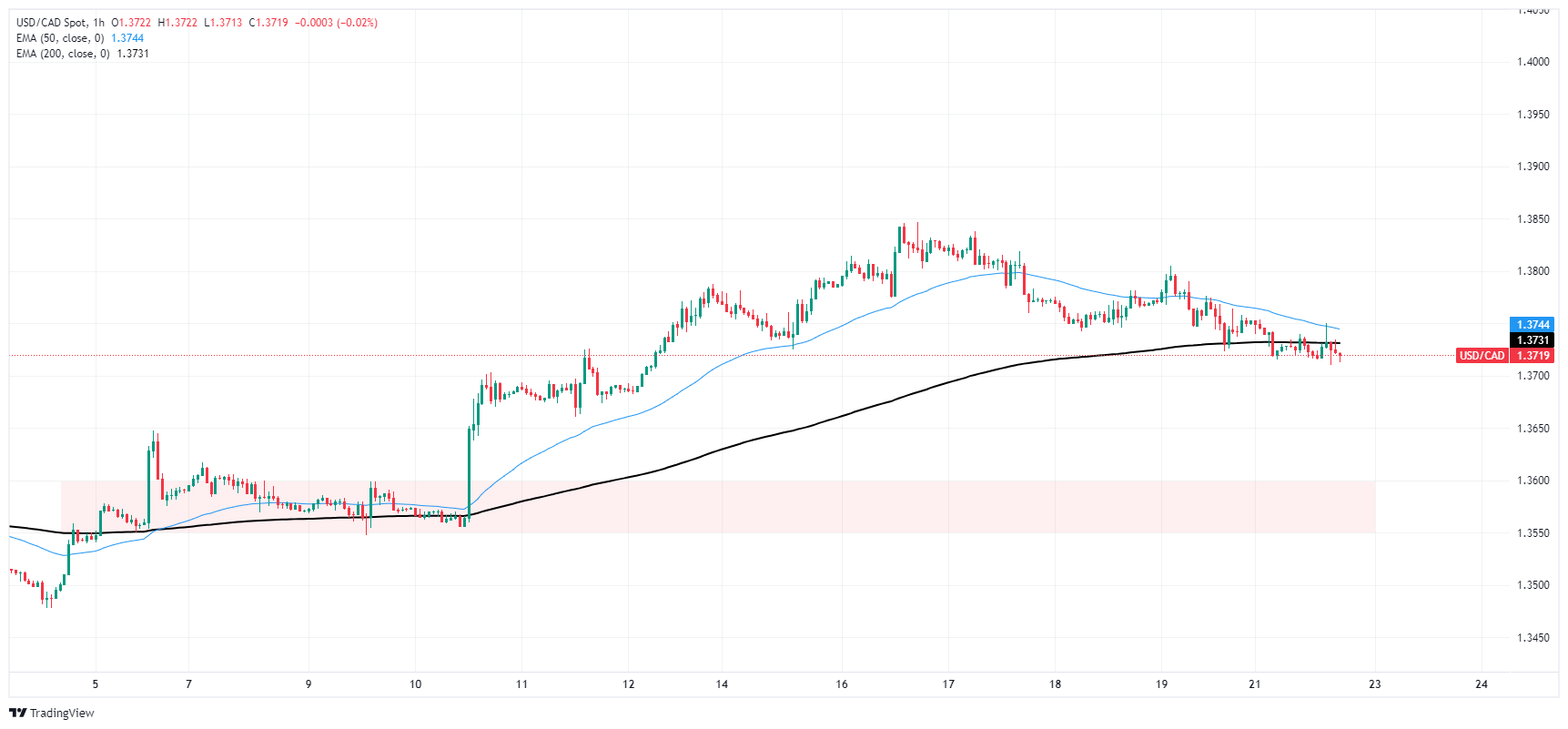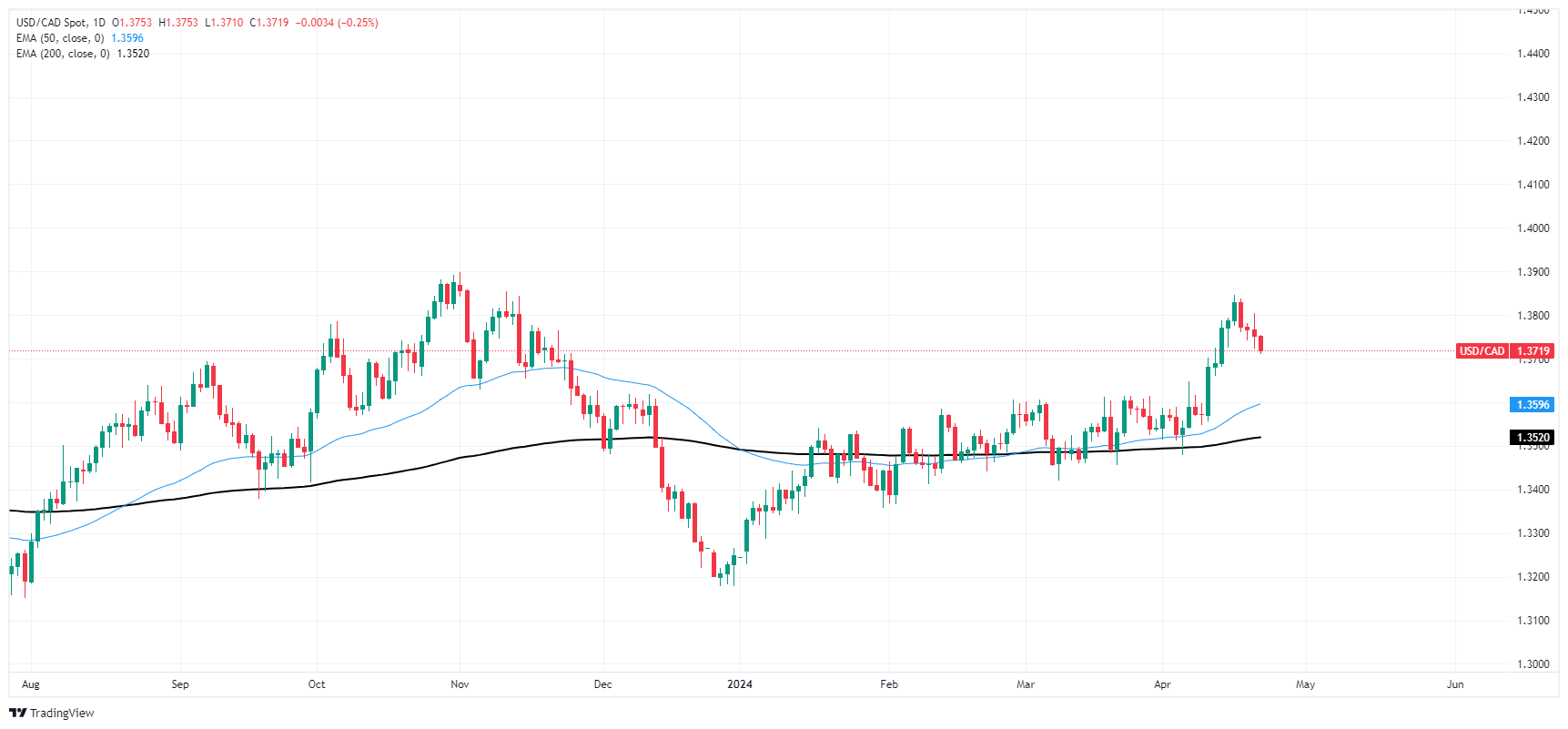- Phân tích
- Tin tức và các công cụ
- Tin tức thị trường
- Canadian Dollar grinds out meager recovery ahead of Tuesday's US PMI figures
Canadian Dollar grinds out meager recovery ahead of Tuesday's US PMI figures
- Canadian Dollar finds room on high side as data-driven markets await US PMI print.
- Canada data remains limited until Wednesday's CAD Retail Sales.
- Tuesday's US PMIs expected to show a slight uptick in activity.
The Canadian Dollar (CAD) is moderately higher on Monday, trading into the green against most of its major currency peers. Monday's thin economic calendar leaves both the Canadian Dollar and the US Dollar (USD) adrift as investors await meaningful data.
Canada brought strictly low-tier data to the table on Monday with an uptick in the Raw Materials Price Index. At the same time, Industrial Product Prices met expectations, printing higher but less than the previous figure. The Canadian New Home Price Index flattened in March, missing forecasts while retreating slightly from the same period last year.
Daily digest market movers: Canadian Dollar extends recovery in steady markets
- Monday’s Canada data saw mixed prints, but market focus remains elsewhere, giving the CAD room to run.
- Canadian Industrial Produce Prices came in at the expected 0.8% in March, easing back slightly from the previous month’s 1.1% (revised upward from 0.7%).
- The Canadian New Housing Price Index flatted in March, printing 0.0% versus the forecast steady hold at 0.1%. YoY NHPI eased back -0.4% as housing prices wobble following years of accelerated growth.
- Canada’s Raw Material Price Index jumped 3.7% in March, vaulting over the forecast 2.9% compared to February’s 2.1%.
- Canadian February Retail Sales due to print in the midweek, forecast to rebound to 0.1% on Wednesday after January's -0.3% decline.
- Tuesday’s US S&P Global Purchasing Managers Index (PMI) will be the key data print for the early week, with the Manufacturing component forecast at 52.0 (previous 51.9) and the Services component also anticipated to print at 52.0 (last 51.7%).
- US Gross Domestic Product (GDP) and US Core Personal Consumption Expenditures (PCE) to dominate market focus in the back half of the trading week.
Canadian Dollar price today
The table below shows the percentage change of Canadian Dollar (CAD) against listed major currencies today. Canadian Dollar was the strongest against the Pound Sterling.
| USD | EUR | GBP | CAD | AUD | JPY | NZD | CHF | |
| USD | 0.11% | 0.26% | -0.19% | -0.24% | 0.12% | -0.20% | 0.14% | |
| EUR | -0.11% | 0.15% | -0.30% | -0.34% | 0.01% | -0.29% | 0.01% | |
| GBP | -0.26% | -0.15% | -0.45% | -0.49% | -0.14% | -0.45% | -0.13% | |
| CAD | 0.19% | 0.30% | 0.45% | -0.05% | 0.30% | 0.00% | 0.31% | |
| AUD | 0.24% | 0.35% | 0.49% | 0.05% | 0.35% | 0.04% | 0.37% | |
| JPY | -0.12% | 0.00% | 0.14% | -0.29% | -0.35% | -0.31% | 0.02% | |
| NZD | 0.19% | 0.28% | 0.42% | 0.01% | -0.04% | 0.30% | 0.30% | |
| CHF | -0.12% | -0.01% | 0.13% | -0.31% | -0.35% | -0.01% | -0.31% |
The heat map shows percentage changes of major currencies against each other. The base currency is picked from the left column, while the quote currency is picked from the top row. For example, if you pick the Euro from the left column and move along the horizontal line to the Japanese Yen, the percentage change displayed in the box will represent EUR (base)/JPY (quote).
Technical analysis: Canadian Dollar mounting a slow recovery, sights on 1.3700
The Canadian Dollar was broadly higher on Monday, gaining four-tenths of a percent against the Pound Sterling (GBP) and nearly a third of a percent against the Swiss Franc (CHF) and the Japanese Yen (JPY). The CAD is outperformed by the Australian Dollar (AUD) and the New Zealand Dollar (NZD) as the Antipodeans recover recently lost ground.
The USD/CAD pair fell from last week’s peak of 1.3840, and a bullish recovery attempt fell short after a bearish rejection from the 1.3800 handle. The pair is now targeting 1.3700, which will clear the way for a push toward a supply zone near 1.3550 as the Loonie leaks below technical support at the 200-hour Exponential Moving Average (EMA) near 1.3730.
Looking longer-term, daily candlesticks have the USD/CAD pair poised for a fourth consecutive down day as the Canadian Dollar extends a near-term recovery. The Greenback failed to recapture November’s highs near 1.3900, and momentum threatens to return USD/CAD back to heavy congestion at the 200-day EMA just above the 1.3500 handle.
USD/CAD hourly chart
USD/CAD daily chart
Canadian Dollar FAQs
The key factors driving the Canadian Dollar (CAD) are the level of interest rates set by the Bank of Canada (BoC), the price of Oil, Canada’s largest export, the health of its economy, inflation and the Trade Balance, which is the difference between the value of Canada’s exports versus its imports. Other factors include market sentiment – whether investors are taking on more risky assets (risk-on) or seeking safe-havens (risk-off) – with risk-on being CAD-positive. As its largest trading partner, the health of the US economy is also a key factor influencing the Canadian Dollar.
The Bank of Canada (BoC) has a significant influence on the Canadian Dollar by setting the level of interest rates that banks can lend to one another. This influences the level of interest rates for everyone. The main goal of the BoC is to maintain inflation at 1-3% by adjusting interest rates up or down. Relatively higher interest rates tend to be positive for the CAD. The Bank of Canada can also use quantitative easing and tightening to influence credit conditions, with the former CAD-negative and the latter CAD-positive.
The price of Oil is a key factor impacting the value of the Canadian Dollar. Petroleum is Canada’s biggest export, so Oil price tends to have an immediate impact on the CAD value. Generally, if Oil price rises CAD also goes up, as aggregate demand for the currency increases. The opposite is the case if the price of Oil falls. Higher Oil prices also tend to result in a greater likelihood of a positive Trade Balance, which is also supportive of the CAD.
While inflation had always traditionally been thought of as a negative factor for a currency since it lowers the value of money, the opposite has actually been the case in modern times with the relaxation of cross-border capital controls. Higher inflation tends to lead central banks to put up interest rates which attracts more capital inflows from global investors seeking a lucrative place to keep their money. This increases demand for the local currency, which in Canada’s case is the Canadian Dollar.
Macroeconomic data releases gauge the health of the economy and can have an impact on the Canadian Dollar. Indicators such as GDP, Manufacturing and Services PMIs, employment, and consumer sentiment surveys can all influence the direction of the CAD. A strong economy is good for the Canadian Dollar. Not only does it attract more foreign investment but it may encourage the Bank of Canada to put up interest rates, leading to a stronger currency. If economic data is weak, however, the CAD is likely to fall.
© 2000-2024. Bản quyền Teletrade.
Trang web này được quản lý bởi Teletrade D.J. LLC 2351 LLC 2022 (Euro House, Richmond Hill Road, Kingstown, VC0100, St. Vincent and the Grenadines).
Thông tin trên trang web không phải là cơ sở để đưa ra quyết định đầu tư và chỉ được cung cấp cho mục đích làm quen.
Giao dịch trên thị trường tài chính (đặc biệt là giao dịch sử dụng các công cụ biên) mở ra những cơ hội lớn và tạo điều kiện cho các nhà đầu tư sẵn sàng mạo hiểm để thu lợi nhuận, tuy nhiên nó mang trong mình nguy cơ rủi ro khá cao. Chính vì vậy trước khi tiến hành giao dịch cần phải xem xét mọi mặt vấn đề chấp nhận tiến hành giao dịch cụ thể xét theo quan điểm của nguồn lực tài chính sẵn có và mức độ am hiểu thị trường tài chính.
Sử dụng thông tin: sử dụng toàn bộ hay riêng biệt các dữ liệu trên trang web của công ty TeleTrade như một nguồn cung cấp thông tin nhất định. Việc sử dụng tư liệu từ trang web cần kèm theo liên kết đến trang teletrade.vn. Việc tự động thu thập số liệu cũng như thông tin từ trang web TeleTrade đều không được phép.
Xin vui lòng liên hệ với pr@teletrade.global nếu có câu hỏi.















